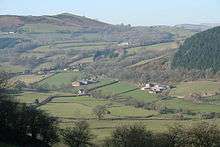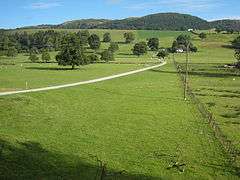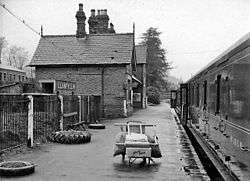Llanfyllin
| Llanfyllin | |
 Llanfyllin Town Square |
|
 Llanfyllin |
|
| Population | 1,482 [1] |
|---|---|
| Language | Welsh |
| English | |
| – London | 180 mi (290 km) |
| Principal area | Powys |
| Ceremonial county | Powys |
| Country | Wales |
| Sovereign state | United Kingdom |
| Post town | LLANFYLLIN |
| Postcode district | SY22 |
| Police | Dyfed-Powys |
| Fire | Mid and West Wales |
| Ambulance | Welsh |
| EU Parliament | Wales |
| UK Parliament | Montgomeryshire |
| Welsh Assembly | Montgomeryshire |
| Website | llanfyllin.org |
Coordinates: 52°45′57″N 3°16′22″W / 52.7658°N 3.2727°W
Llanfyllin (![]() Welsh pronunciation ) is a small market town in a sparsely-populated area in Powys, Wales. Llanfyllin's population in 2011 was 1,482, of whom 34.1% could speak Welsh.[1] Llanfyllin means church or parish (llan) of St Myllin ('m' frequently mutates to 'f' in Welsh).
Welsh pronunciation ) is a small market town in a sparsely-populated area in Powys, Wales. Llanfyllin's population in 2011 was 1,482, of whom 34.1% could speak Welsh.[1] Llanfyllin means church or parish (llan) of St Myllin ('m' frequently mutates to 'f' in Welsh).
Geography

The town lies in the valley of the River Cain near the Berwyn Mountains in Montgomeryshire, 14 miles (23 km) southwest of Oswestry and 15 miles (24 km) from Montgomery. The River Cain is joined by the small River Abel in Llanfyllin (presumably named after Cain and Abel in the Bible), and meanders through the valley, flowing into the River Vyrnwy at Llansantffraid.[2]
History
The town lies between Shrewsbury and Bala,[2] for a long time the key market towns in this area of Wales and the Welsh borders. At nearby Bodyddon there is evidence of an early British settlement.[2] Llanfyllin may be the "Mediolanum among the Ordovices" described in Ptolemy's Geography (c. AD 150),[3] although others argue for Meifod[3][4] or Caersws.[5]
The town is known for its holy well, Fynnon Coed y Llan. The well is dedicated to Saint Myllin, who is reputed to have baptised people here in the sixth century.[2][6] The parish church is also dedicated to Saint Myllin. There is a tradition that Saint Myllin is the Irish bishop, Saint Mo Ling (also named Moling Luachra) (614–697). However, this is uncertain. There is no record of Mo Ling travelling to Wales, and there is a tradition that Myllin is buried under the altar of Llanfyllin church whereas Mo Ling is believed to have been buried at his monastery in Ireland.[7][8][9][10]
The medieval motte and bailey castle of Tomen yr Allt was probably destroyed by Llywelyn ap Gruffudd in 1257. The castle earthworks are still present.[11][12]
Llanfyllin was granted a charter as a market town in 1293 by Llywelyn ap Dafydd under Edward I, one of only two Welsh towns to have received its charter from a native ruler. The charter was confirmed by Edward de Charlton, Lord of Powys under Henry V.[2][13]
Buildings
Llanfyllin is noteworthy for the quality and quantity of its buildings in locally-made brick.[14]

Church of St Myllin
The parish church of St Myllin (Church in Wales) was founded in the seventh century, according to tradition by St Myllin. The present building which dates to around 1706 is mainly of locally-made red brick with battlements and a Welsh slate roof. It has a tower with six bells. It was adapted and extended by 1863 in the neo-Norman style, and restored in 1959.[14][15]
Pendref Chapel
Pendref Chapel (Congregationalist) is said to be the oldest Welsh independent church in Powys. In 1640 its first minister was Vavasor Powell. The chapel was initially built in 1708. The chapel was destroyed in the Jacobite rising of 1715, and was re-erected at government expense. The present building dates from 1829.[14]
Rhosfawr hall house
A late-15th or early-16th century hall house at Rhosfawr (52°47′04″N 3°20′22″W / 52.7844°N 3.3395°W) near Llanfyllin is a Grade II* Listed Building. It has been used as a barn since the 17th century and has never been altered, and is perhaps the most complete and unaltered medium-sized hall house in Wales. It consists of four bays, crucks at the gables, a central truss, box-frame trusses and two tiers of trenched purlins with heavy curved wind braces. The central bays formed the hall.[16]
The Hall
An historic house known as The Hall still exists on Vine Square within the town.[17] Its origins as Plas Uchaf (Welsh for Upper Hall) are 16th century, it is a T-shaped two-storey timber-framed building with an attached open hall, remodelled in about 1599 adding a floor in the hall and stairs between the house and the hall. It was further remodelled in 1832 with the addition of an extra storey and three gables facing the square.[17] King Charles I stayed at The Hall in November 1643.[18] The Hall is Grade II listed.[17]

Bodfach Hall

Bodfach Hall is a Grade II listed building about 1 km north-west of Llanfyllin in the hamlet of Bodfach.[19] It is likely that a house was built on the site after the destruction in 1257 of Tomen yr Allt, a motte-and-bailey castle which stood on one of the hills above it.[19][20] The property is first recorded in 1160 in the will of Madog ap Maredudd, Prince of Powys. Sion Kyffin, a descendant of Madog, extended a house on the site in 1661, as recorded in an inscription above an old door on the west of the house.[19] The house was considerably modified and extended over the years and was rebuilt c. 1870. In 1945 the estate was broken up; most of the land was bought by its tenant farmers, and the hall and 33 acres were sold to one buyer to become an hotel.[19][20]
Llanfyllin Golf Club (now defunct) was founded in 1909 in Bodfach Park; the president was Sir John Lomax, the owner of Bodfach Hall and former High Sheriff of Montgomeryshire.[20][21] It was a 9-hole course with a membership of 40 in 1914. It disappeared after World War I.[21]

Llanfyllin Union Workhouse
Llanfyllin is also increasingly well known for the old Union Workhouse, known as Y Dolydd (Welsh for The Meadows) locally, and built in 1838.[22][23] This old Victorian building had stood empty since the mid-1980s until a local voluntary group, the Llanfyllin Workhouse Project, got involved and are slowly renovating it to make a local centre for Arts, Creativity and the Environment.[24] It is also home to the Llanfyllin Workhouse Festival.[25]
Notable people
- William Morgan (1545–1604), translator the Bible into Welsh, was appointed rector of Llanfyllin in 1579. He was at the same time vicar of nearby Llanrhaeadr-ym-Mochnant. He was later Bishop of Llandaff and of St Asaph.[26]
- Tomos Prys (Thomas Price) (c.1564–1634), soldier, sailor, buccaneer and poet, is said to have lived in The Hall.[18]
- Roger Palmer, 1st Earl of Castlemaine (1634–1705), courtier, diplomat and politician lived in The Hall.[18] He was the husband of Charles II's mistress Barbara Palmer and was James II's ambassador to the Vatican.[27]
- Thomas Price (died 1704), an antiquary and recusant, lived in Llanfyllin, probably at The Hall.[28] Saunders Lewis mentioned Price in his 1962 radio lecture Tynged yr Iaith (The Fate of the Language).[29]
- Ryan Davies (1937–1977), entertainer and star of the BBC1 television show Ryan and Ronnie, lived at the Union Workhouse as a child, when his parents were managing an old-people's home in the building.[30]
Education
The town has a primary school, and the bilingual Llanfyllin High School with approximately 1,000 pupils from the town and the surrounding area, about a quarter of whom travel from Shropshire, over the English border. The 2009 inspection of the High School reported GCSE examination results as well above the local and national average.[31]
Transport

The town sits on the main route between Welshpool and Bala. The A490 road connects the town to Churchstoke, and terminates just after passing through the town.
The Llanfyllin Branch of the Cambrian Railways opened in 1863, to provide access to the limestone quarries along the valley, terminating at Llanfyllin station.[32] The main line from Oswestry to Newtown (Powys) closed in 1965, as did the branch line to Llanfyllin, under the "Beeching Axe".
The Lonely Tree of Llanfyllin
The Lonely Tree of Llanfyllin was a large Scots Pine in an isolated position on Green Hall Hill above the town (at 52°45′45″N 3°15′02″W / 52.7624°N 3.2506°W). It was estimated to have been 200 years old. It featured in several local traditions: it was hugged for good fortune, marriages were proposed at the tree and cremation ashes were scattered beneath it.[33]
The Lonely Tree was named Wales Tree of the Year 2014 by the Woodland Trust, and was entered in the 2015 European Tree of the Year competition.[34][35] It fell in a storm in February 2014. An unsuccessful attempt was made to rescue it by packing its roots with nearly sixty tonnes of earth.[33][36]
References
- 1 2 "Area: Llanfyllin (Ward) Welsh Language Skills, 2011 (KS207WA)". Office for National Statistics.
- 1 2 3 4 5 "Llanfyllin". The National Gazetteer. 1868. Retrieved 2012-02-11.
- 1 2 Williams, Robert. "A History of the Parish of Llanfyllin" in Collections Historical & Archaeological Relating to Montgomeryshire, Vol. III, p. 59. J. Russell Smith (London), 1870.
- ↑ Newman, John Henry & al. Lives of the English Saints: St. German, Bishop of Auxerre, Ch. X: "Britain in 429, A. D.", p. 92. James Toovey (London), 1844.
- ↑ Roman Britain Organisation. "Mediomanum?" at Roman Britain. 2010.
- ↑ "St.myllin's Well Coed Y Llan, Llanfyllin". Retrieved 17 April 2015.
- ↑ "Church of St Myllin,Llanfyllin". The Clwyd-Powys Archaeological Trust. Retrieved 19 April 2015.
- ↑ "St Myllin's Church, Llanfyllin". Mathrafal Deanery. Retrieved 19 April 2015.
- ↑ Webb, Alfred (1878). A Compendium of Irish Biography. Dublin: M. H. Gill & Son. p. 342. Retrieved 19 April 2015.
- ↑ Baring-Gould, Sabine; Fisher, John (1911). The Lives of the British Saints, Volume 3. London: The Honourable Society of the Cymmrodorion. p. 489. Retrieved 21 April 2015.
- ↑ "Tomen Yr Allt Motte". The Clwyd-Powys Archaeological Trust. Retrieved 24 April 2015.
- ↑ Smith, J Beverley (2014). Llywelyn Ap Gruffudd: Prince of Wales. University of Wales Press. p. 99.
- ↑ Steele, K. (3 January 2009). "Llanfyllin". Coflein. The Royal Commission on the Ancient and Historic Monuments of Wales. Retrieved 24 April 2015.
- 1 2 3 Haslam, Richard (1992). The Buildings of Wales: Powys (1 (with corrections) ed.). Penguin Books, University of Wales Press. pp. 131–136. ISBN 9780300096316. Retrieved 12 May 2015.
- ↑ Steele, K. (17 November 2008). "St Myllin's Church, Llanfyllin". Coflein. The Royal Commission on the Ancient and Historic Monuments of Wales. Retrieved 24 April 2015.
- ↑ "Cruck Barn at Rhosfawr, Cwm Nant Fyllon, Llanfyllin". British Listed Buildings.
- 1 2 3 "The Hall, Vine Square, Llanfyllin". British Listed Buildings. Retrieved 17 April 2015.
- 1 2 3 The Royal Commission on The Ancient and Historical Monuments and Constructions in Wales and Monmouthshire (1911). An Inventory of the Ancient Monuments in Wales and Monmouthshire, Vol. 1 - County of Montgomery. London: His Majesty's Stationery Office. pp. 95–97.
- 1 2 3 4 "BODFACH HALL". Coflein. Retrieved 22 April 2015.
- 1 2 3 "A Brief History Of Bodfach Hall, Montgomeryshire". The Bodfach Trust.
- 1 2 "Llanfyllin Golf Club, Powys.". Golf's Missing Links. Retrieved 22 April 2015.
- ↑ "Llanfyllin, Montgomeryshire".
- ↑ "Llanfyllin and district- The Union Workhouse - A Victorian prison for the poor". Victorian Powys.
- ↑ "Llanfyllin Workhouse - The Project".
- ↑ "Workhouse Festival, Llanfyllin".
- ↑
 Lloyd, John Edward (1894). "Morgan, William (1540?-1604)". In Lee, Sidney. Dictionary of National Biography. 39. London: Smith, Elder & Co.
Lloyd, John Edward (1894). "Morgan, William (1540?-1604)". In Lee, Sidney. Dictionary of National Biography. 39. London: Smith, Elder & Co. - ↑ "Palmer, Roger". Oxford Dictionary of National Biography (online ed.). Oxford University Press. doi:10.1093/ref:odnb/21209. (Subscription or UK public library membership required.)
- ↑ "Price, Thomas Sebastian". Dictionary of Welsh Biography. The National Library of Wales. Retrieved 17 April 2015.
- ↑ Lewis, Saunders (13 February 1962). "Tynged yr Iaith" [The Fate of the Language] (in Welsh). National Library of Wales. Retrieved 29 April 2015. Translation at "Fate of the Language". Blog Carl Morriss. Retrieved 29 April 2015.
- ↑ "Davies, (Thomas) Ryan". Oxford Dictionary of National Biography (online ed.). Oxford University Press. doi:10.1093/ref:odnb/101155. (Subscription or UK public library membership required.)
- ↑ Thomas, William Gwyn (25 June 2009). "A report on the quality of education in Llanfyllin High School". Estyn. Retrieved 23 April 2015.
- ↑ "Llanymynech Heritage Area". Clwyd Powys Archaeological Trust. Retrieved 2012-02-10.
- 1 2 Vidal, John (8 March 2014). "Welsh town comes together to save 'Lonely Tree'". The Guardian. Retrieved 5 March 2015.
- ↑ "Llanfyllin's 'Lonely Tree' is Wales' tree of the year". BBC News. 23 November 2014. Retrieved 5 March 2015.
- ↑ Barkham, Patrick (4 March 2015). "It's the Eurovision for trees! Which one will you root for?". The Guardian. Retrieved 5 March 2015.
- ↑ Williams, Sally (5 June 2015). "Wales' majestic Lonely Tree has died a year after being felled by storms". Wales Online. Retrieved 24 November 2015.
Further reading
- "Llanfyllin" (PDF). Historic Settlement Survey - Montgomeryshire. Clwyd Powys Archaeological Trust.
External links
| Wikimedia Commons has media related to Llanfyllin. |
- www.geograph.co.uk : photos of Llanfyllin and surrounding area
- Llanfyllin Town F.C. website
- Llanfyllin High School website
- Llanfyllin Workhouse - arts, education and community website
